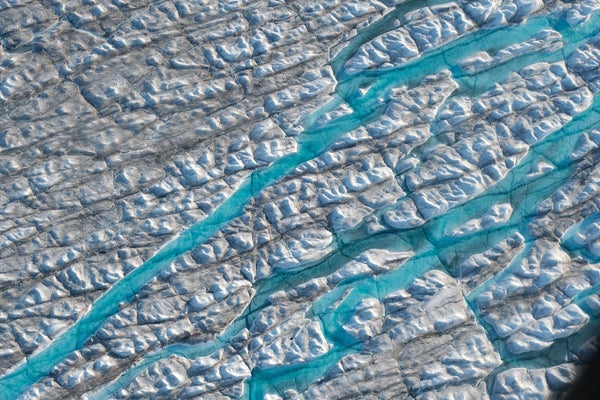Greenland’s massive ice sheet, which is thawing because of human-induced climate change, could be saved from complete meltdown even if global temperatures soar past key international targets, a study suggests. But rescuing the ice in these conditions would require huge future cuts in atmospheric greenhouse-gas levels — and would not prevent the ice sheet from melting enough to cause up to several metres of sea-level rise.
Using climate modelling, the research concludes that Greenland’s melting will accelerate abruptly if the average global temperature crosses a threshold that is no higher than 2.3 °C above pre-industrial levels — and could be much lower. That threshold might be getting quite close: 2023 is likely to record an average temperature 1.5 °C above pre-industrial levels. The landmark 2015 Paris climate treaty aims to limit warming to 2 °C, and ideally to no more than 1.5 °C. But even if temperatures shoot up by 6 °C or more above pre-industrial levels, humanity will be able reduce much of that ice loss if warming is then throttled back to 1.5 °C within a few centuries, the study shows.
“We do not necessarily tip the Greenland ice sheet just because we crossed these thresholds,” says Nils Bochow, a climate scientist at UiT The Arctic University of Norway in Tromsø and lead author of the study, which appears today in Nature.
On supporting science journalism
If you're enjoying this article, consider supporting our award-winning journalism by subscribing. By purchasing a subscription you are helping to ensure the future of impactful stories about the discoveries and ideas shaping our world today.
Still, he and others are quick to note that taking action against climate change now will be cheaper and easier than trying to claw back global temperatures later. “It’s a bet against time if we don’t do anything now,” Bochow says. “It gets only harder the longer we wait.”
Running out of margin
Greenland holds enough ice to raise global sea levels by 7 metres if it were all to melt. The sheet currently loses around 270 billion tonnes of ice each year, and contributes a substantial fraction of the current global sea-level rise, which is more than 4 millimetres annually.
June, July, August and September 2023 all saw record high global temperatures, and 2023 is likely to be the hottest year for which data exist. Against this backdrop, Bochow and his colleagues wanted to look at what would happen if humanity overshot the 1.5 °C temperature target, even by a lot, and then managed to cool things down again.
“It’s a worthwhile tool to explore because what we are doing so far, policy wise, is not enough to be within the limits,” says Michele Petrini, an Earth-system scientist at the NORCE Norwegian Research Centre and Bjerknes Centre for Climate Research in Bergen.
Keeping it cool
The researchers used two climate models to assess how the Greenland ice sheet would respond to a variety of scenarios. Like previous studies, the analysis found that the worst impacts of warming could be avoided if warming is kept below 2.5 °C.
Even if the planet were to exceed 2.5 °C of warming, the Greenland ice sheet would probably not melt completely — as long as the average global temperature increase came back down close to the Paris targets in a matter of centuries. However, Earth would still be locked into sea-level rise of up to several metres, which would devastate coastal areas. “Our results highlight the critical role of warming and cooling rates,” the authors wrote.
There are many caveats. The work does not incorporate a host of shorter-term planetary changes, such as shifts in ocean currents, that could affect Greenland’s ice. The authors examine the effect of average global temperature increases rather than temperature increases in the Arctic, which are happening at least three times faster than those in the rest of the planet. And the study assumes that society will somehow work out a way to slash greenhouse-gas emissions drastically in the future, perhaps through carbon-capture technology. “We must keep in mind that this is just a conceptual experiment,” says Petrini.
Bochow says he doesn’t want people to think the Greenland ice sheet is going to be fine. “There’s a chance to prevent some serious consequences even if there’s no political will now,” he says. “But we should act today rather than later.”
This article is reproduced with permission and was first published on October 18, 2023.
